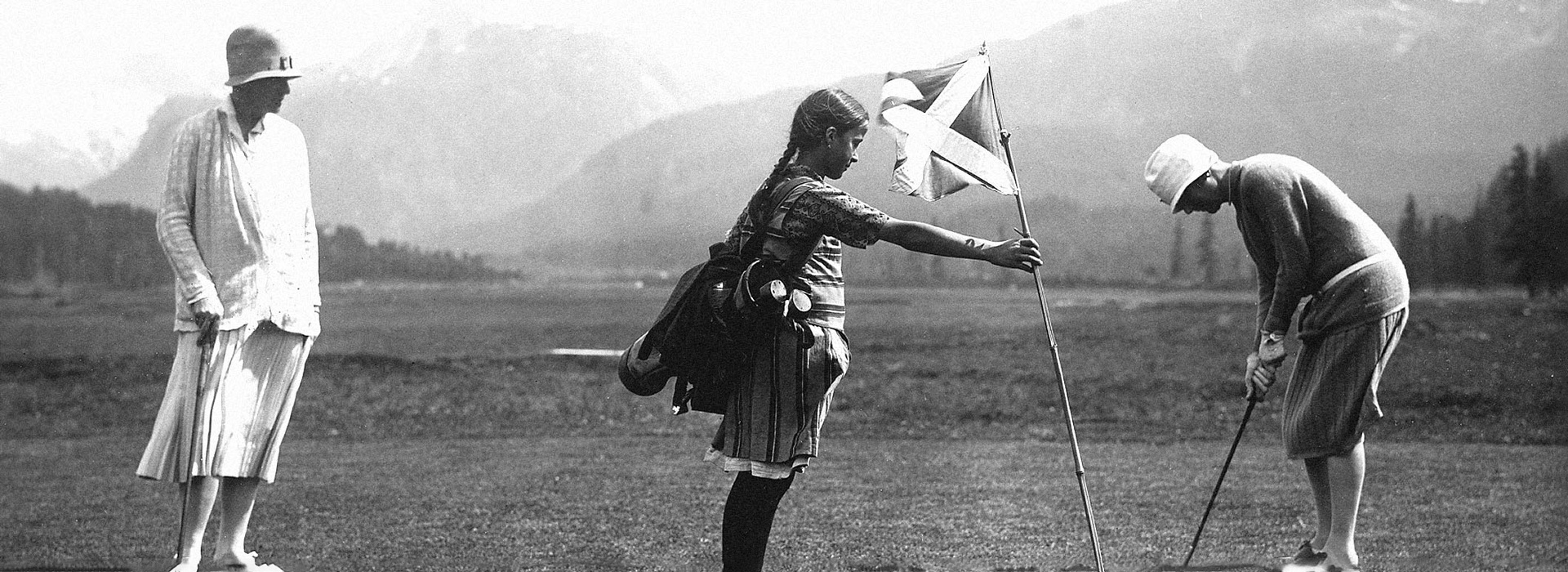Walk of History
Along the Driving Range in Samedan the «Walk of History» tells the history of the Engadine Golf Club on 16 panels: from the foundation of the golfclub to the development of the club house till the sustainability project for the 125th anniversary.
The «Walk of History» is open daily. Free access.
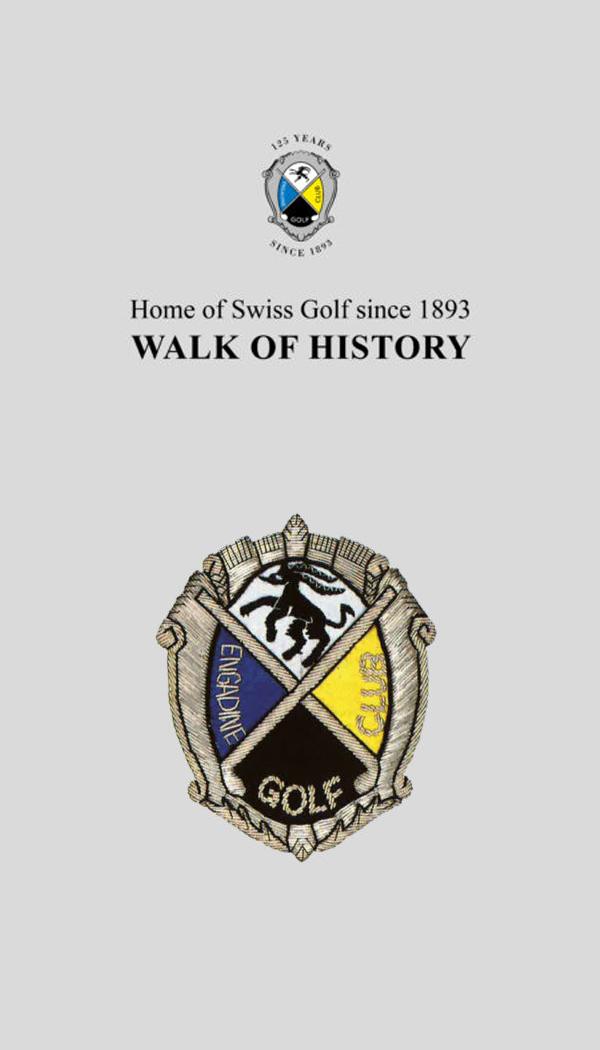
Home of Swiss Golf
Founded 125 years ago, the Engadine Golf Club in Samedan is the oldest golf club in Switzerland and the sixth oldest golf club on the European continent. Everything started in summer 1889, when hotel pioneer Conradin von Flugi travelled to England to assess the options for building a golf course in the Engadine. The result was a nine-hole course situated between today’s railway station and St. Moritz Bad. This course was first mentioned in the «Engadine Year Book» of 1890 which rated it as «very sporty». Thus it was the people of St. Moritz and their guests who first provided golf with a home on the old continent. Golf was soon taking the Engadine by storm, and the Municipality of Samedan granted Hotel Bernina permission to build an 18-hole golf course on the Champagna plain. The director of Hotel Bernina, Angelo Fanconi, assumed the role of Honorary Secretary of the Engadine Golf Club when it was founded in Samedan in 1893. The first tournament was held on 1–2 August 1893. According to extensive coverage in the «The Alpine Post», the Mixed Foursome («Members Only») was the most important tournament.
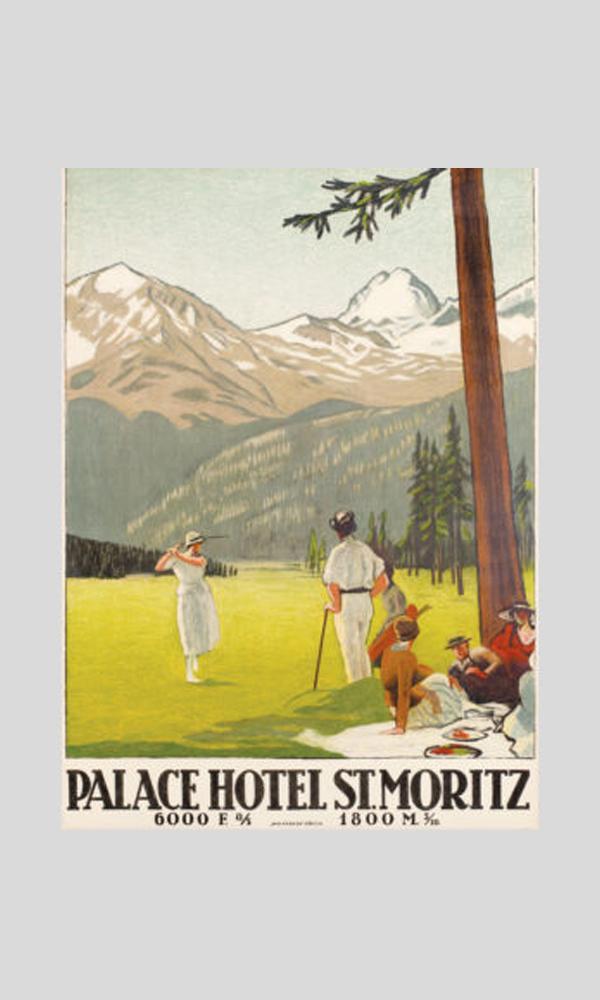
Home of Swiss Golf
The Engadine Golf Club had already been active for nine years when the Association (ASG) was founded in Lucerne in 1902. Besides the Engadine Golf Club, Montreux and Lucerne were also involved. The first ASG President was the English parliamentarian Arthur H. Crosfield, who is considered a key figure in the early development of golf in the Engadine and throughout Switzerland. In the ASG, each club had the right to a seat on the board, which added up to no less than 14 vice-presidents in 1910. According to the book «100 Jahre ASG» (100 Years of the ASG), the General Assembly of 1911 resolved to limit the number of vice-presidents to 28. The Second World War saw all tournaments in the Engadine suspended, and the absence of guests led to dire financial straits at the Engadine Golf Club. The club had to reorient itself. Fortunately, Badrutt’s Palace Hotel stepped in and provided funding on loan. Proprietor Hans Badrutt was already a generous patron of the club and – like his son Andrea later – its long-standing president.
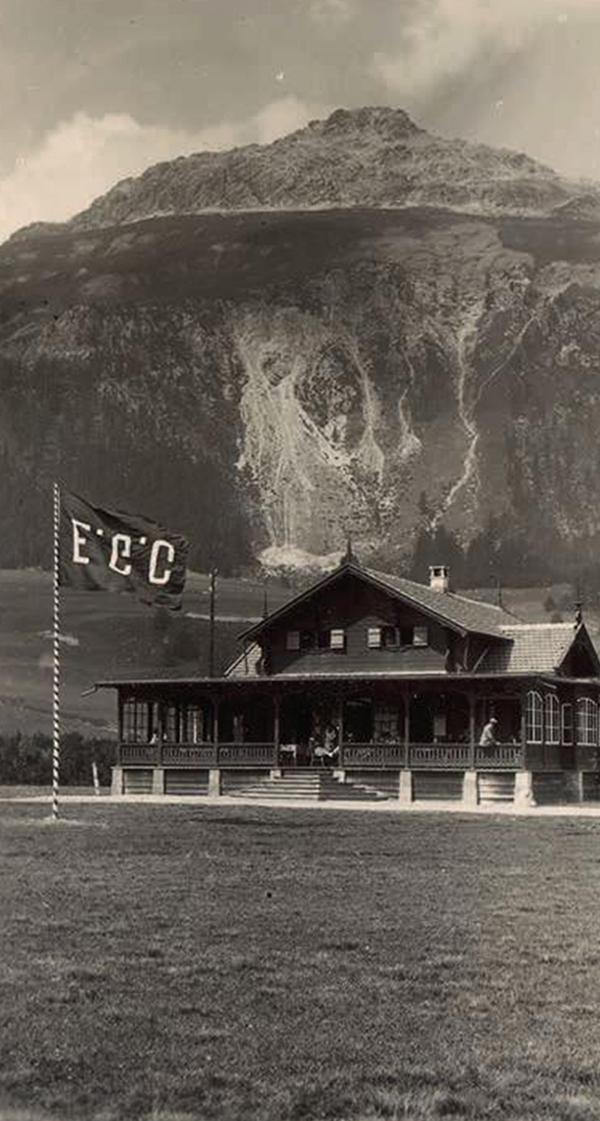
From pavilion to clubhouse
The old Engadine Golf Club clubhouse in Samedan would have many stories to tell. The first pavilion, from which afternoon tea was served during the first tournaments, was built in 1893. It was a simple, dirty, almost cowshed-like hut that was as draughty as a sieve and only offered a measure of protection from wind and weather. The «new» clubhouse was built in 1901, a small, pretty building resembling a Swiss chalet, that promised spaciousness and attractiveness from the first glance. It comprised a dining room and men’s and women’s changing rooms. At the front of the building, a pleasant veranda of about ten by three metres tempted visitors to take afternoon tea and enjoy the glorious view across the valley. The clubhouse cost CHF 10,000. By 1913 the clubhouse had reached its limits; it was too small and needed extending and some additional new furniture. The CHF 50,000 for the construction was covered by donations and 70 guests were welcomed to the traditional «Fourth of July» dinner in the spacious new dining hall. The lovely veranda remained as inviting as ever. In 1983 the cosy clubhouse made way for the building we see today: the new clubhouse with more space and comfort was needed to meet the demands of the members and guests. A restaurant with a large terrace overlooking the golf course, a pro shop and secretary’s office, plus women’s and men’s changing rooms.
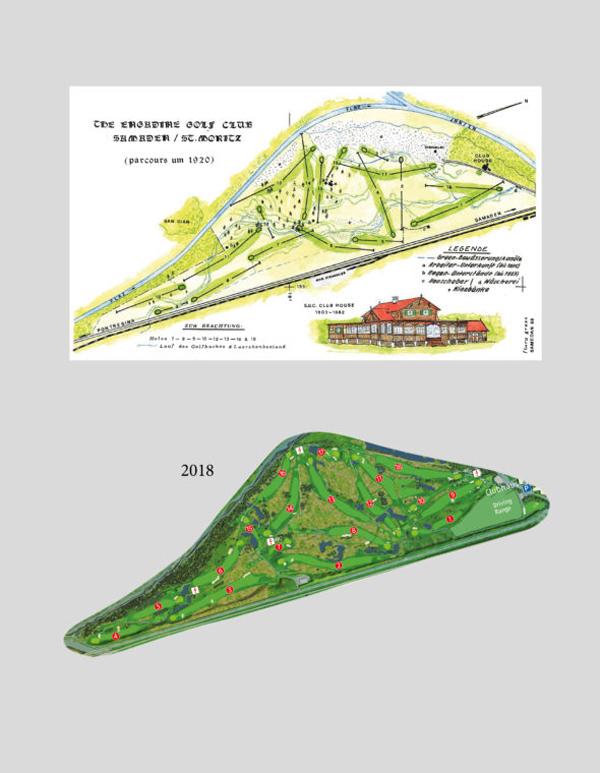
Samedan, the links course
The opening of the course in Samedan was described in 1893 as follows: «The golf course is built on sandy ground with short-napped, scrawny grass. It has sufficient bunkers, though these are regrettably not actually sand traps, but the wide bed of an all-but-dried-up stream. The course layout is fairly simple and designed for straight drives. The turf is excellent and offers a fairly firm playing surface.» In the 125 years of its existence, the Samedan golf course has undergone several architectural corrections: the layout of the fairways has been changed, the tees renewed, the greens raised or relocated, the streams and lakes filled with water and much more. In 1988 the course was redesigned by golf-course architect Mario Verdieri as a «New Course» and, but for a few changes, was almost identical to the current golf course in Samedan.

Caddies? Caddies!
Caddies were an integral part of every golf course in the early years of golf. On the Samedan course, local boys and girls, including some who were later to become famous artists such as Giacometti or Segantini, earned good pocket money as caddies, who in those days carried the golf bags of the players – members and guests. One of the guests was John Plant, an Englishman who came to St. Moritz every year for three months, staying at Badrutt’s Palace Hotel. He supported the club with his knowledge over many years. He used to take a caddie out on the course, and they recall: «John Plant was something of the grand seigneur of golf. He was tall and good-looking and at 70 still had a handicap of five.» As golfing materials evolved, the caddies disappeared. Today most golf bags are made of light, water-repellent material and can easily be carried or mounted on a golf trolley – whether manual pull or electric. Caddies have all but disappeared from amateur golfing. In professional tournaments, caddies continue to be an important element of success, advising on the choice of club and reading the greens.
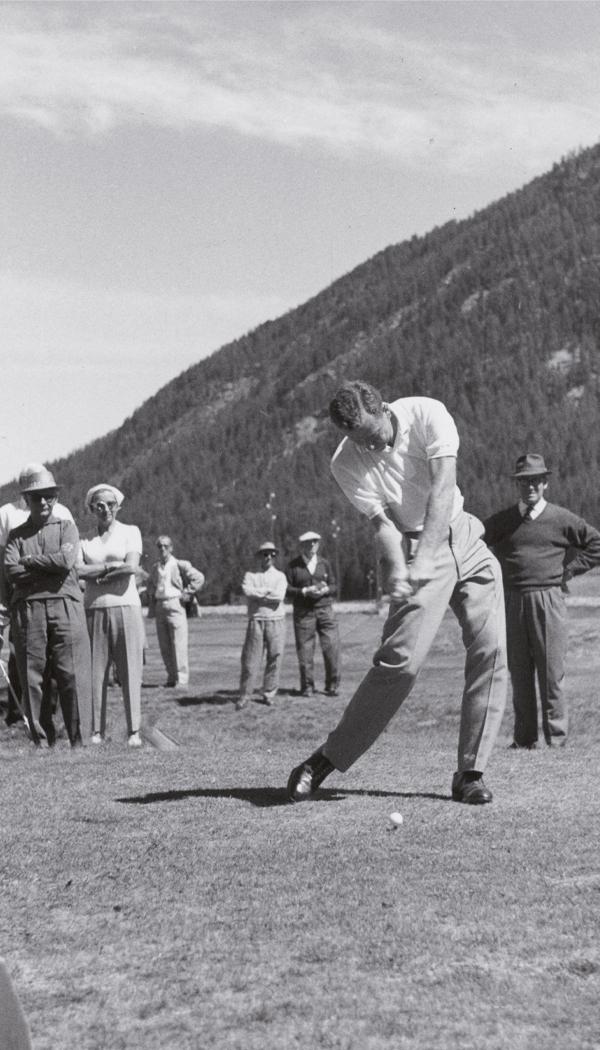
The Engadine Amateur Championship
The first amateur golf tournament in Switzerland was held on 19 August 1893, and is still held annually as the Engadine Amateur Championship. The ladies’ championship was played over nine holes and a Mrs. Mosely won with 59 strokes. The gentlemen played over 18 holes and Mr. H.H. Springman won with 84 strokes. The tournament, two days of stroke play over 36 holes, has taken place since 1893 and has seen many eminent winners over the years: Mr J. Plant, Mr U. Lamm, Mr M. Frank und Mr. Martin Rominger, Playing-Pro Engadine Golf Club. Also two ladies managed to join the rankings: 1995 Mrs. P. Moore and 2010 Miss C. Casanova. More recently the championship has been played over three days and 54 holes. Still stroke play and with a strict handicap policy: no handicap above 11.0 and no more than 120 participants. If too many registrations are received, the handicap threshold will be reduced even further. Incidentally, the first Swiss Open took place on the Samedan golf course in 1923, the precursor to today’s Omega European Masters, which has been held in Crans Montana since 1923.
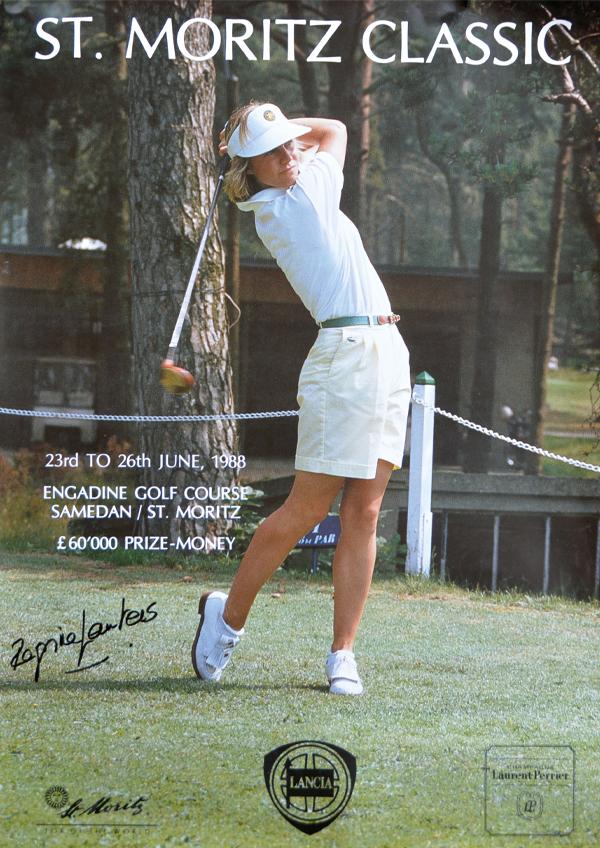
The St. Moritz Classic
The St. Moritz Classic was held on the golf course in Samedan in 1988 and 1989. The best players on the Tour had come together to compete at some 1,700 metres above sea level. The 1988 winner was from New Zealand: with a four-round total of 285 strokes, Janice Arnold received prize money of CHF 9,000. In 1989 Kitrina Douglas from England won with 286 strokes and was able to take home CHF 10,500 in prize money.
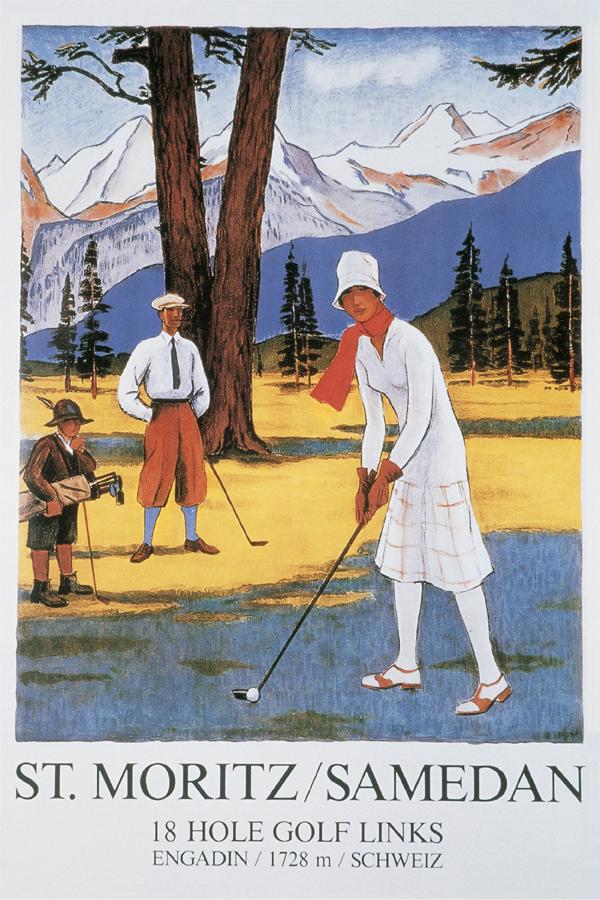
Unlimited golfing
St. Moritz and the Engadine are among the most renowned golf destinations in the Alps. Golfing at over 1,700 metres above sea level in one of the most beautiful high-altitude valleys, not to mention the breathtaking Alpine panorama, is an absolute highlight for many keen golfers in summer. Located close to the golf courses, the wide selection of Engadine Golf Hotels – about 30 in all – are perfectly placed for exclusive golfing holidays. Ideal in combination with the wide culinary choice available in the Engadine. In the history of the Engadine Golf Club, there’s no overlooking certain illustrious people and moments. First and foremost the famous names who came to Samedan to play golf. Prince Max of Baden, for example, or Aga Khan, who set up a tournament and was followed by many high-profile championships and prominent personalities. Another was Scottish actor Sean Connery, famed for his role as James Bond, who turned up at the Samedan golf course for a foursome in 1981 and, it is told, «had a sense of humour bigger than the 18 holes on the course».

The greens become whites
Winter golf in St. Moritz! 75 years passed from the idea to its realisation. The first tournament on snow took place in 1979 on the frozen Lake St. Moritz. Golf can be played all year round like almost no other outdoor sport. The former resort manager, Peter Kasper, took up the idea from 1904 and turned it into reality – with success. Luminous balls are almost a must, the greens are white and there is a whole lot of snow around: that’s winter golf. The «whites» need a lot of manual work to make the surface around the hole compact and as true as possible. Winter golf has been played every January since 1979. Originally at Lake St. Moritz, in Silvaplana since 1996, it is very popular with players and spectators alike.
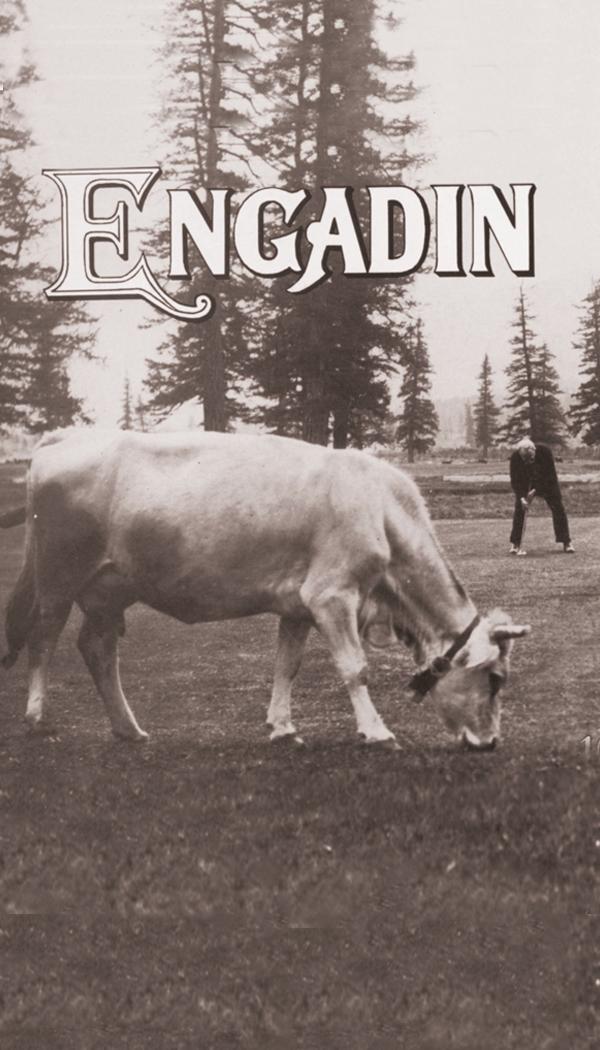
Mind the cows!
On old photos you can still see a celebrity player or two who took his dog round the course with him. Lord Tyrrell, for example, the British ambassador to Paris, always strolled down the fairways with «Mike», his English bulldog. Then in the 1980s dogs were banned, and at the same time the cows also disappeared thanks to a deal with the farmers. After the snow melted, the farmers were accustomed to bringing their animals to the course for a few weeks, built as it was on common land. The greens had to be protected with electric fencing to prevent the cows from trampling all over them, and the fairways had to be cleared of cow pats every day because they scorched the grass under them. «This cost so much that it was ultimately cheaper to pay the farmers CHF 3.50 per animal per season and have them graze elsewhere,» Mario Verdieri, who negotiated with the farmers, remembers. Architect Mario Verdieri has renovated the golf course several times and was responsible for the clubhouse, which was newly built in 1983.

Two golf courses – two worlds
This is a very apt comparison when it comes to the two courses. Both courses – Samedan and Zuoz-Madulain – leave nothing to be desired for the discerning golfer. Standing on the terrace of the Samedan Golf Course, which was opened in 1893, one is easily overwhelmed. The view across the Flaz river plain to a unique mountain panorama makes the visitor forget for a moment why he came here. The utterly flat golf course – with its larch trees, some of which are over 700 years old, their tops tousled by storms and lightning strikes, and with the many small streams and little lakes – makes it very tempting to try some power golf. But overconfidence here is rarely a good thing. All the greens are well defended. Not just by bunkers, but also by trees or bushes and a lot of water. Accurate approach shots are called for along with a bit of savvy. And when the Maloja wind blows from noon on, the golfer needs to summon his last reserves of strength to complete a course that suddenly feels so much longer. Strength is also needed at the golf course in Zuoz-Madulain, which opened in 2003. In contrast to Samedan, this course involves constant slight ups-and-downs, and takes a certain degree of fitness, not just because of the varied course design. But here too it is important to use your head. Which is sometimes not easy when you keep getting distracted all over again by the fabulous views of the Engadine mountains or the historic villages of Zuoz and Madulain.
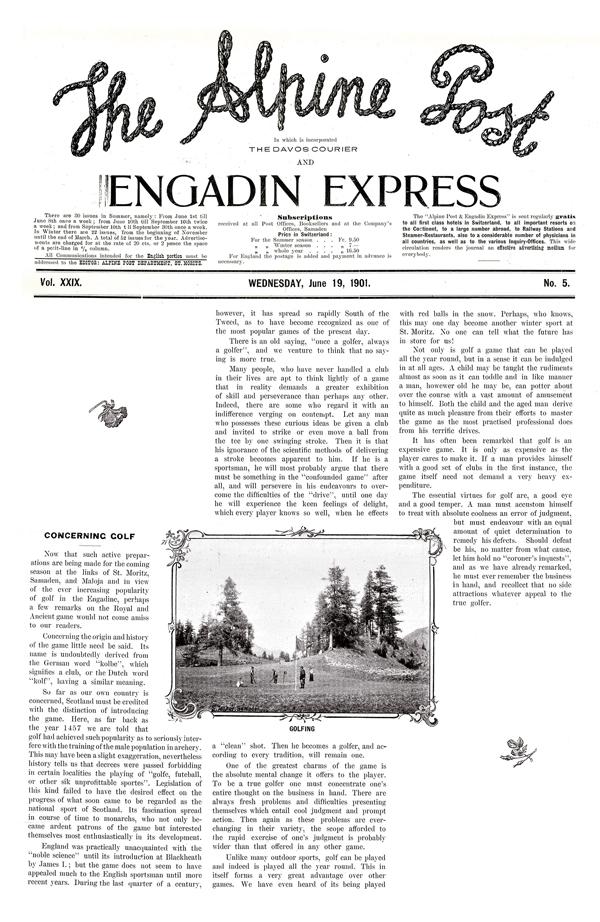
The Alpine Post
The course in Samedan is not only the oldest golf course in Switzerland: things have happened and still do happen on it like on no other golf course. It was first mentioned on 14 June 1893 in «The Alpine Post». Shortly after the opening of the course, the author of the text is enthusiastic about the «short-napped, scrawny grass and the wide bed of an all-but-dried-up stream…». It was a time when breakfast sandwiches were washed down with a Lanson Extra Dry. «The Alpine Post» reported regularly on the activities – and for some locals, the curiosities – that took place on the course in Samedan. In the issue dated 28 July 1908, Tom Morris gave «Advice for Young Golfers» and in the 4 August issue an article on «Golf – a Matter of Honour» was published. The Engadine Golf Club has revived «The Alpine Post» for the 125th Anniversary and published the planned activities for the anniversary year 2018 in the issue dated 1 August 2017.
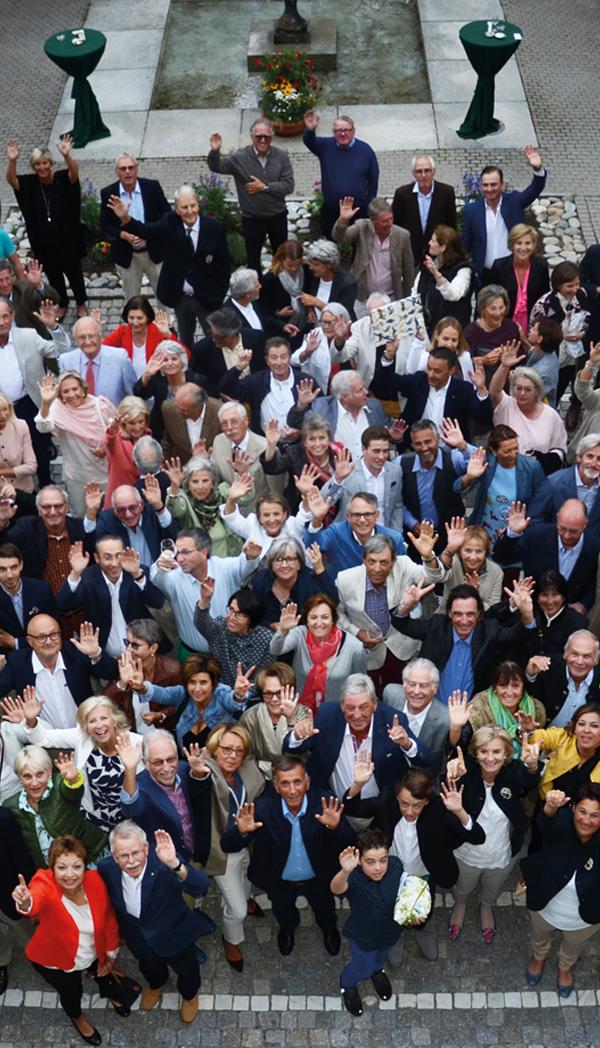
Welcome to the Club
Belonging, making friends and enjoying a round or two! Blackballing was the name English clubs once gave to the admission process for new members. A jury voted on each membership application by dropping black and white balls into an urn. It took just a single black ball – and the candidate was rejected. Of course this is no longer done today, especially not in the Engadine Golf Club. But membership of a club is now back in fashion again. Membership of the Engadine Golf Club offers a good network, not just for playing golf, but also for meeting friends. Of the 1,250 or so members, some 70% are active golfers in 2018, including 140 juniors. In addition to the many sporting tournaments, club life is also a social affair: each summer, the Ladies, Seniors and Juniors sections offer a wide range of events to help people to meet and mix or do something together, besides playing golf. Courses and taster days supply basic information about playing golf and choosing the right club for the shot. Anyone who’s heard the short «thwack» of a perfectly hit ball can’t help but be infected with the golf bug. Welcome to the Club!
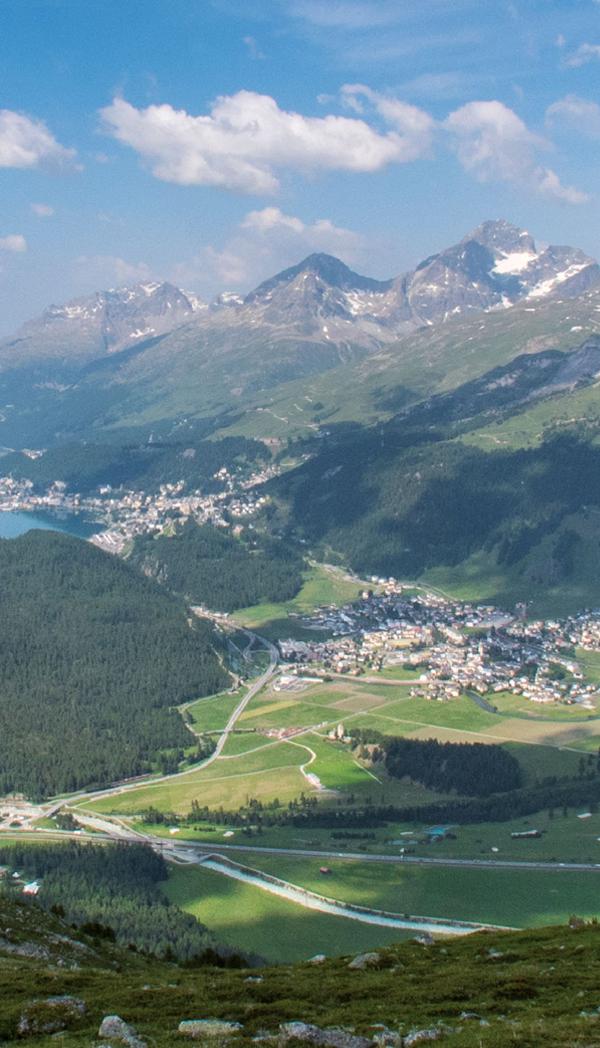
Three golf clubs become one
Founded in 1893, the Engadine Golf Club was joined by the St. Moritz Golf Club in 1902, and – as the oldest golf club on the European mainland – still had about 174 members in 2007. The Samedan Golf Club was formed in 1950, bringing together the local golf enthusiasts. With almost 800 members, it was the largest of the three golf clubs in the Engadine. 1998 saw the founding of the Zuoz Golf Club as the youngest golf club in the Engadine, numbering 320 members. These three Upper Engadine golf clubs merged prior to the 2008 golf season. With the merger, the resulting Engadine Golf Club is one of the largest golf clubs in Switzerland with over 1,300 members, who have the unique opportunity of playing on two excellent golf courses in the Engadine. As the oldest golf club, the Engadine Golf Club places a great priority on upholding tradition. Tradition means not only preserving that which is good and has proven its worth, but also being open to new ideas. The desire is to cultivate golf in the Engadine and focus on the essence of the game: the joy of golf!
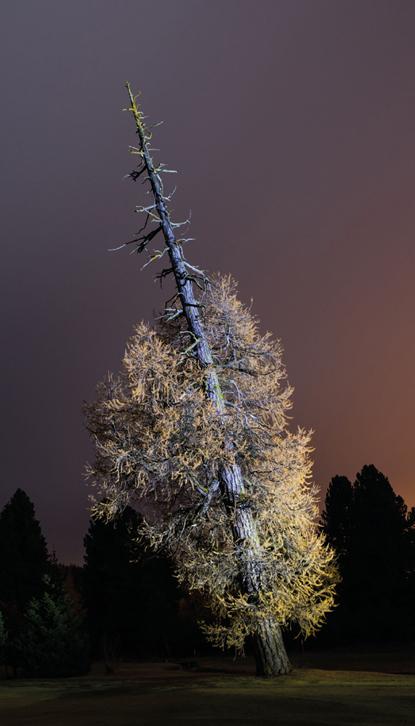
125 larches for the golf courses
In 2015, the Engadine Golf Club decided to celebrate its 125th anniversary by launching a new sustainability project. The idea was to plant 125 larches on the two golf courses in Samedan and Zuoz-Madulain by the Anniversary, to ensure the survival of the tree population and the uniqueness of the two golf courses. The trees are a particularly prominent feature of the 18-hole championship course in Samedan. The particular lines of sight and swing angles around the larches have sometimes forced golfers to make an unintentional ‘chip’ or ‘roll ball’. Depending on the position of the golf ball, the trees may mean that a player is unable to reach the green or even the fairway with a clean swing. Members and guests were invited to buy a larch so that it could be planted in their name. The project met with an overwhelming response, with all 125 trees sold and ready to plant within a single golfing season. The 125th larch was planted in spring 2017, and now all the larches are delighting the golfers – some less so, no doubt, depending on where the golf ball lands.
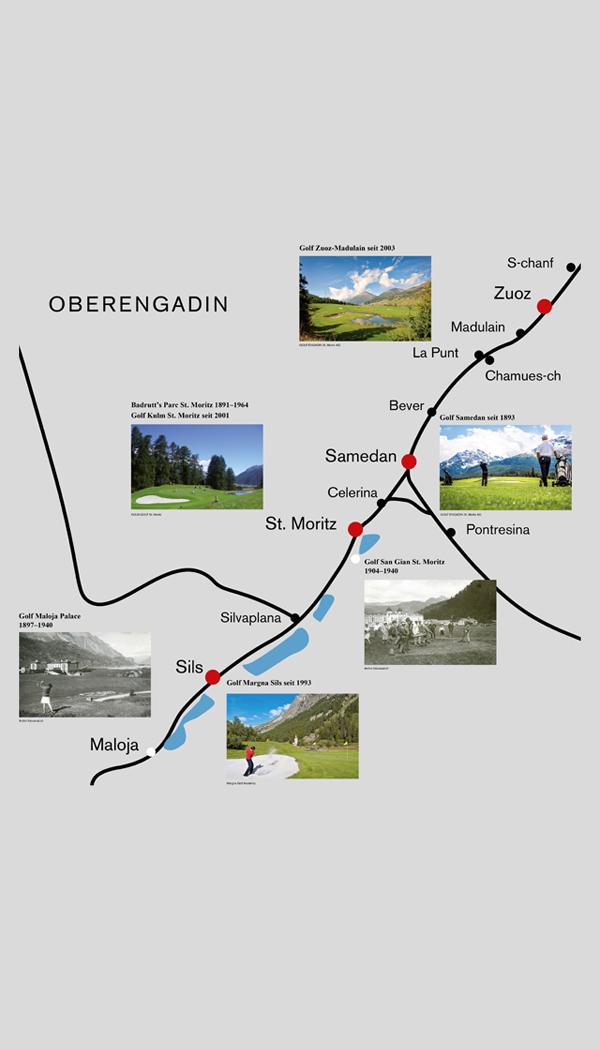
1893–2018 Golf courses in the Engadine
The tradition of golf courses in the Engadine goes back a long way. In 1891, a nine-hole course was built at the Kulm Hotel St. Moritz for the guests, who were almost exclusively British. After being converted into tennis courts and a restaurant in 1964, the golf course reopened in 2001 on the initiative of St. Moritz golf course architect Mario Verdieri. In 1904, another nine holes were added in the St. Moritz-San Gian area, but these were given up in 1940 due to the War. The history of golf at the Palace Hotel in Maloja lasted slightly longer. The golf club was founded in 1897 and for a while expanded to 18 holes. In 1931 the course was reduced to nine holes, but was then taken over for agricultural purposes during the Second World War. In 1993 the six-hole par-three practice course was built at the Parkhotel Margna in Sils, adding to the golfing facilities available in the Engadine. Today, four golf courses in the Engadine, 51 holes in all, extend an open invitation to enjoy a round of golf: Golf Margna Sils with the six-hole par-three practice course at Parkhotel Margna Sils, Golf St. Moritz with the executive nine-hole course at Kulm Hotel St. Moritz, Engadine Golf Club with the two 18-hole championship courses in Samedan and Zuoz-Madulain.









